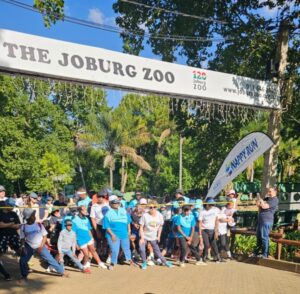
Khethiwe Nkuna on World Suicide Prevention Day

By Khethiwe Nkuna
As organisations double down on their Diversity, Equity, and Inclusion (DEI) goals, disability inclusion often remains at the edge of the conversation — mentioned, but rarely meaningfully prioritised. This is especially true when it comes to leadership. While progress has been made in promoting gender and racial equity in senior roles, disability inclusion continues to lag behind.
It’s time to broaden our definition of inclusive leadership.
True leadership equity is not just about who gets into the room — it’s about who feels empowered to lead once they’re there. It’s about succession planning that includes everyone, mentorship that builds confidence, and sponsorship that opens doors, especially for leaders with disabilities.
Why Disability Inclusion in Leadership Is a Strategic Imperative
Globally, over 1.3 billion people have some form of disability — that’s approximately 16% of the world’s population. Yet despite this, leaders with disabilities remain significantly under-represented in executive roles, C-suites, and on boards.
This absence doesn’t just reflect a lack of inclusion — it represents a missed opportunity. Leaders with disabilities bring unique assets to the table:
- Lived empathy that sharpens people management
- Resilience built through navigating inaccessible systems
-
Innovation honed through adapting creatively to environments that weren’t built with them in mind
These are not deficits. They are leadership superpowers.
So why do we still exclude them from the top?
By the Numbers: The Leadership Gap
The statistics speak for themselves:
- Fewer than 1% of executives in Fortune 500 companies publicly identify as having a disability, despite data suggesting the actual number is likely much higher.
- 71% of employees with disabilities report concerns about their advancement prospects due to bias, stigma, and lack of support in leadership pathways.
-
Companies that champion disability inclusion are 4 times more likely to outperform their peers in total shareholder returns, and see 28% higher revenue, according to Accenture’s Getting to Equal Report.
This isn’t just a moral imperative — it’s a business one. Disability inclusion is a catalyst for performance, innovation, and culture.
3 Key Levers: How to Advance Disability Inclusion in Leadership
1. Mentorship That Empowers, Not Pities
Mentorship is a critical tool for leadership growth — but it must be framed through an empowering, not paternalistic, lens. For emerging leaders with disabilities, having mentors who:
- believe in their potential,
- reflect their ambitions,
- and help them navigate unspoken organisational codes
is transformational.
Companies should:
- Create structured mentorship programmes that include disabled employees at all levels.
-
Train mentors to avoid ableist assumptions and instead cultivate high expectations and mutual respect.
 “Mentorship changed everything for me — not because someone gave me sympathy, but because they challenged me to lead unapologetically.”
“Mentorship changed everything for me — not because someone gave me sympathy, but because they challenged me to lead unapologetically.”
– Anonymous leader with a disability
2. Succession Planning That Doesn’t Filter Out Differences
Many succession planning models are built around narrow ideals of leadership: assertiveness, physical presence, constant availability, or “executive presence.” These criteria are often steeped in ableist assumptions.
We must:
- Redefine what leadership looks like in accessible and inclusive terms.
- Build future pipelines by actively identifying and investing in disabled employees who show leadership potential.
-
Audit leadership development programmes to ensure they’re fully accessible — from physical access to digital tools to psychological safety.
If your next CEO has a disability, will your systems support them or shut them out?
3. Sponsorship That Opens Doors, Not Just Hearts
Sponsorship is often what moves leaders from potential to position. Unlike mentorship, sponsorship involves advocacy — someone in power using their influence to elevate someone else’s career.
For leaders with disabilities, sponsorship is essential to:
- Gain access to key projects and promotions
- Be “in the room where it happens”
-
Be defended when bias creeps into decision-making
But this can’t happen passively. Senior leaders must be encouraged — and held accountable — to sponsor inclusively.
From Accommodations to Empowerment
Too often, disability inclusion is reduced to compliance: installing ramps, adjusting workstations, or allowing flexible hours. While these accommodations are necessary, they’re only the starting point.
Real inclusion is about creating cultures of belonging where leaders with disabilities:
- Feel psychologically safe to disclose
- Are not defined by their disability
-
Can influence culture, strategy, and vision at the highest levels
This requires both structural and cultural shifts. It’s about leadership with people with disabilities — not just leadership for them.
Voices That Need to Be Heard
Here are reflections from disabled professionals on the importance of representation:
“When I finally saw someone like me leading a department, I realised I wasn’t aiming too high. I was aiming too small before.”
– Senior HR Manager, living with a visual impairment
“Every time I had to hide my disability to be taken seriously, I chipped away at my own leadership confidence. We shouldn’t have to choose between being authentic and being respected.”
– Director, tech sector
Final Word: Leadership Belongs to Everyone
Leadership must reflect the full spectrum of human experience — and that includes disability. We cannot build equitable workplaces if we continue to leave disabled professionals out of the conversation, the pipeline, and the boardroom.
Inclusion without leadership is incomplete.
So let’s ask: Who are we mentoring? Who are we sponsoring? Who do we see when we imagine the next generation of leaders?
Let’s commit to seeing, developing, and uplifting leaders with disabilities — not as exceptions, but as essential contributors to the future of work.
Ready to audit your leadership development for disability inclusion?
Let’s work together to build pathways that are open, accessible, and truly inclusive.






